News
Govt. allegedly in bed with millers to rig rice market
 Standing by the roadside, farmers of Polonnaruwa often watch lorries hauling paddy to the stores of private millers. The paddy is being transported from the interior areas of Ampara and Batticaloa, where the harvest has been good.
Standing by the roadside, farmers of Polonnaruwa often watch lorries hauling paddy to the stores of private millers. The paddy is being transported from the interior areas of Ampara and Batticaloa, where the harvest has been good.
In two weeks, the harvesting is expected to begin in most other districts as well.
So why is the Government importing rice? Farmers in Polonnaruwa ask.
They say the Government and private millers have paddy stocks in warehouses, while at the time an artificial shortage of rice has been created to justify imports and drive down local paddy prices.
Farmer G. A. Gurusinghe from Giritale in Polonnaruwa and a leader of a farmer group told the Sunday Times that the Government purchases just five percent of the paddy production and allows 95 percent to be sold to private millers.
He said large scale millers with the financial power and political connections hold the paddy in their storages creating a scarcity in the market.
“In previous years, the Government imported rice and caused our paddy prices to plummet. This year, the millers are also free to import making our paddy worthless in the market,’’ he said.
Gurusinghe said large scale millers are buying paddy at the lowest prices and are selling at the highest price. He claims that although the Government buys paddy for Rs 38 to Rs 40, the private millers buy it for just Rs 19 to Rs 30.
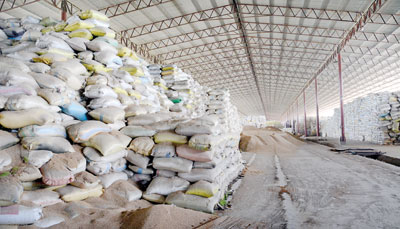
Enough to feed the whole country? A private mill in Pollonnaruwa. Pix by M.D. Nissanka
“They know that we have to pay workers we hired, return borrowed money, meet transport expenses and pay our utility bills. They know we need the money urgently so they get away with it,’’ he said.
Another Polonnaruwa farmer, W. P. Sumanasiri, said in the past the Government would purchase the paddy and store them in Sathosa warehouses and other storages, but that this no longer exists.
“Since the economy opened up, private millers gained power and were able to collect large amounts of paddy compared with Government bodies and began to regulate stocks. Large scale millers now decide the price of paddy,’’ he said
He alleged that the Government overplayed the drought as a cover to import rice, when only the rains were delayed.
“There is enough paddy in the warehouses of large scale millers. If those stocks are released we will have enough rice until April. Imports are unnecessary,’’ he said.
Another farmer, also from the Girithale area, K. T. A. Milton, said stocks of paddy are held for years in warehouses of the Government and stores of large scale millers.
At times such stocks in Government storage are destroyed on the grounds that it is ‘unfit for consumption’, or sold off as animal feed.
The farmers claim that a few politicians are supporting the paddy mafia. These politicians scuttle moves to create farmer and consumer friendly policies.
The Sunday Times team visited the New Rathna Rice Mill (PVT) Ltd., Polonnaruwa, which claims to be the largest in Sri Lanka and the largest production line in South Asia.
Its warehouses are as big as football fields. The machinery fills a five kilo bag in less than five seconds.
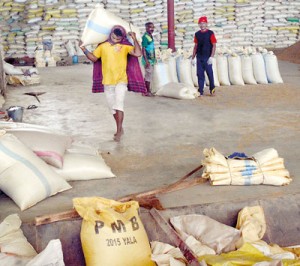
Still in storage: 2015 Yala harvest
Managing Director, Lankeshwarage Mithrapala, said the company had enough capacity to provide rice for the whole country.
He said the company has started purchasing paddy from Ampara for Rs 38 per kilo.
Mithrapala defended the imports saying that due to a shortage of nadu, they imported an Indian verity of nadu (sewn nadu), while the harvest was also expected to be low. “I only import about 10 percent Indian rice, while the rest of my stocks are local rice,’’ he said.
Mithrapala said 50,000 metric tonnes have to be maintained as a buffer stock. The company needs to purchase as much paddy as possible.
He denied that large scale millers are mixing foreign and local rice. He claims such mixed rice would taste different.
He added that he only stored rice for one-and-a-half years, but that it tastes better when stored for longer.
Mithrapala also claimed that he had stocked some rice in his mill because the farmers claim that he sells Indian rice passing them off as local rice.
Farmers point out though there is a rush to purchase paddy, when the need arises in the market, stocks are not released.
Small scale mill owner as well as the president of United Rice Millers Association, Mudith Perera, said imported rice will be stored by the large scale millers and later used as animal feed.
He explained that rice is imported to drive down the prices of local varieties so that they could be purchased at lower prices. “The big time millers are creating the local rice shortage and waiting till harvesting ends,’’ he said.
“Since they have stocks they have the monopoly on distribution and decide on paddy and rice prices.’’
Millers have become so powerful they even use small scale millers and their representatives to buy Government stocks.
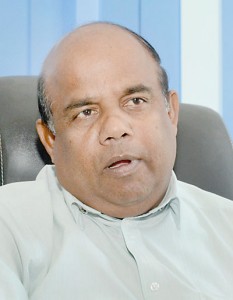
Managing Director of Polonnaruwa mill: Lankeshwarage Mithrapala
“There are only about 30 small scale millers capable of converting paddy to rice but the Government offered paddy to about 130 millers,’’ he said.
He said small millers are willing to charge lower rates, but that the bulk of the paddy is offered to large scale millers.
“The Government doesn’t even have a plan to buy paddy. They should create a mechanism to prevent large scale millers from controlling rice prices,’’ he said.
While the Government buys paddy for Rs 40 per kilo, large scale millers buy it for Rs 20.
He recalled how last year imported rice stocks were destroyed by the Paddy Marketing Board because they had passed sell-by dates. “They also store old stocks of paddy and claim they are unable to buy more because the stores are full.’’
Meanwhile, the Polonnaruwa district secretary, Ranjith Ariyaratne, said harvesting is yet to begin and the drought has not affected cultivation.
He said that 66 percent of the cultivation has survived. He explained although prices have not been determined, Sathosa and the PMB will make purchases.
“The Sathosa store rooms have not been used for a long time,’’ he said.
He said that he was also aware of claims by farmers that paddy is hoarded by the millers but that without complaints they cannot intervene.
“The PMB and Consumer Affair’s Authority should raid the warehouses,’’ he said.
PMB Chairman, M. B. Dissanayake, said the board can only acquire five percent of the paddy, while the remainder is provided to the private sector.

president of United Rice Millers Association, Mudith Perera
“We are unable to control the large scale millers at gun point, so the Government can only have a fixed price for both local and foreign rice,’’ Dissanayake said.
He explained that the Government has only 60,000 metric tonnes of paddy in warehouses and is in the process of selling the paddy to mills and Sathosa.
However, figures obtained by the Sunday Times from Government Agents in some of the paddy cultivation areas show that Government stores had more stocks.
Dissanayake said the PMB buys paddy for Rs 38 to Rs 40 a kilo and will try to prevent paddy prices from being driven down further.
The PMB was selling the buffer stock to make space for the new harvest. He said 350,000 metric tonnes of paddy can be stocked in 300 stores including Government warehouses. But the PMB only purchases 1,500 metric tonnes, because the board only buys 5 percent of the harvest.
Minister of Rural Economic Affairs, P Harrison, said rice was being imported due to the drought but that PMB warehouses are being cleared. He declined to comment on Government plans for purchases.
Meanwhile, the Director General of the Agriculture Ministry said that out of 800,000 hectares of paddy land expected to be cultivated during the Maha season 750,000 hectares have been cultivated.
“Therefore an estimated 1.4 million metric tonnes of paddy [1.4 billion kilos] can be collected by the first week of April,’’ he said.
It was only in 2015 that the Central bank highlighted the need that Sri Lanka needs to concentrate on exporting excess rice stocks in view of the harvest. In 2015, the bank said the estimated paddy production was 3.3 million metric tonnes of rice sufficient to meet demand for 17 months.
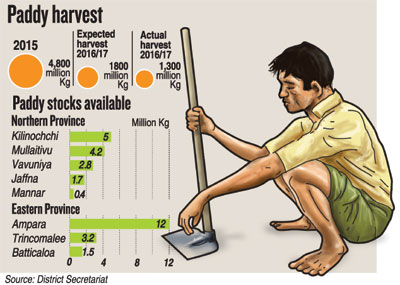
| Importation of rice: Auditor Generals  recommendations not heeded?With the issue of importation of rice taking center stage once again, serious questions have been raised whether concerned authorities paid heed to recommendations made by the Auditor General regarding rice imports. The Auditor General who looked into the import of 257,000 metric tons of rice in 2014/2015 and found that bad practices including disregard for government tender procedures had resulted in the loss of over Rs15 billion to the country, made several recommendations to prevent a repetition of massive losses to the state. The AG who undertook the inquiry at the request of the Parliamentary Committee on Public Enterprises (COPE) made several recommendations. They include: 1. The need to pay due attention to the data and information of the Central Bank of Sri Lanka and the Department of Census and Statistics relevant to the overall position of the country in reaching decisions relating to productivity, demand and importation of rice. 2. As the Lanka Sathosa is a State Company, the need to carry out a proper supervision of its activities by the Department of Public Enterprises, the Department of Management Audit, the Department of Treasury Operations and the Department of Management Services of the General Treasury. 3. The need for obtaining accurate data on the local requirement of rice, paddy production and the overall stocks in the country before taking decisions for the importation of rice. 4. The need for the officers responsible to supply the required information in the Cabinet Memorandums presented to the Cabinet of Ministers in order to enable the Cabinet to take correct decisions. 5. Follow the provisions in the Government Procurement Guidelines. 6. The annual registration of eligible suppliers and purchases so that in an emergency situation they could be invited to give quotations. 7. The need to introduce a proper stock control methodology for every sale outlet and store.   |

Farmer G. A. Gurusinghe

Farmer W P Sumanasiri
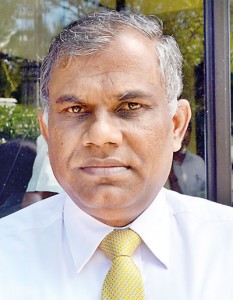
Polonnaruwa district secretary, Ranjith Ariyaratne

